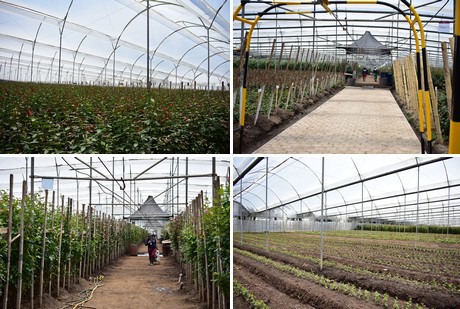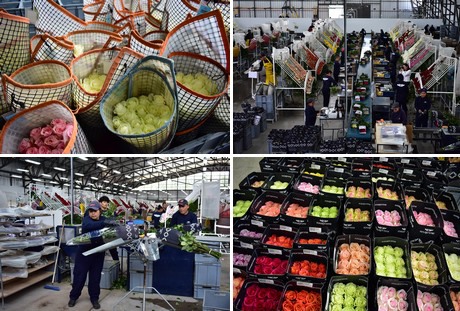At Rosaprima, the largest rose farm in Ecuador, they grow 150 varieties on 136 ha in four farms. They are continuously investing in improving their crop by using new technologies, methods to reduce their environmental impact and providing the best work and social conditions for their employees. Last week, FloralDaily.com had the opportunity to visit one of their farms so that we could see it all. This article offers just a small glimpse of what they do.
Juan Martin Gomez in the greenhouse
We visited one of the four farms in Cayambe, with a size of 73 ha. In this greenhouse, next to producing commercial varieties, Rosaprima also tests new varieties from different breeders. Around 50 varieties from 10 to 12 breeders are being tested. "We receive 10 plants from the breeder and turn it into 1000 plants. Then, we trial the color, stem length, and head size", says Juan Martin Gomez, Chief Quality Officer at Rosaprima. "For a grower, it is always good to test varieties in your own greenhouse. Then you know the variety and its habits and from there on, it offers a better chance to get exclusivity on varieties."

Crop protection
When walking down the greenhouse, one can directly notice something that is a little different compared to other farms: the mint plants that are planted at the end of the beds. "It is a technique that we use to minimize the pests. They act as a deterrent to aphids and other potential pests, as well as ensuring the quality and optimal moisture of the soil. They are widely used on our farm", says Gomez.
Mint planted at the end of the beds
Something else that strikes one's attention are the hedges of lavender planted in between the greenhouses. "In this warmth we try to keep the insects out of the greenhouse. Insects prefer lavender over the plants in the greenhouse."
Lavender planted outside the greenhouse
But there are more measures being taken to protect the crop, though they're not so clearly visible. "We treat the plants with gas, instead of spraying." This practice is very efficient, as it needs only one person to manipulate the machine versus 6 people needed to spray.
Lately, they started trialing with different bugs (Acoro) that kill other bugs, and types of fungus that kills bad fungi. "We have tested it for five years in a lab and now we're trying it commercially." On top of that, they are working hard to attain the ideal climate for good fungus. "Good fungus results in better quality soil", adds Gomez.
Their methods are combined with agrochemicals that have been approved not only by the Ecuadorian government, but also through the Rainforest Alliance Standard, which ensures these are tried and tested through a “state-of-the-science risk assessment process.
New techniques
Also regarding the use of techniques and automation, they are continuously developing. One new technique that we have seen is the “sky-line”- an automatic system that transports the flowers from the farm to the post-harvest area, which results in a better vase life of the rose. "In the past, a worker had to walk with carts and bring flowers from all corners of the greenhouse to the post-harvest area. It could take him up to 1.5 hours from the last block to the post-harvest area."
Now, with this new automated cart system, the flower nets are attached to the rail and directly transported to the post-harvest area. "This new process only takes the flowers 20 minutes or less to arrive."
As a result, the rose will have a vase life of about five more days.
Nets are brought into the post-harvest area automatically. The nets are tagged in the greenhouse, so there is traceability from the field to the box.
Another technical innovation is their water management system. They are one of the few farms in Ecuador that has an irrigation system that saves over 300 million liters of water per year. "It not only ensures maximum efficiency of water use, but also guarantees our plants receive the right amount to grow the most beautiful roses. We also ensure our waste water is treated and constantly measure the levels of nitrates of our soil to avoid any contamination of aquifers."
In addition, Rosaprima’s water reservoir increases their use of rainwater, and it creates a healthy ecosystem for the native flora and fauna of the region.
But there is more...
When walking on the farm, one could see carts with flower waste. Gomez explained that this waste is used as compost - maximizing the efficiency in recycling and re-integrating nutrients into the soil. "All vegetative waste arising from the pruning and elimination of plants, as well as any rose products that will not be commercially used, are sent on site to be composted. We use a combination of traditional composting methods, including worm composting, to produce a highly rich organic fertilizer that reduces the need to use any external fertilizers in our soil."
 Post harvest process; from arriving in the nets to ready for export
Post harvest process; from arriving in the nets to ready for export
And let's not forget their employees. Since their inception in 1995, they see their employees as the greatest assets, and are investing in not only them, but also in their families. "For example, we offer free medical services for our workers and their families. We also have a program that gives scholarships to the children of our employees with the highest grades in school."
For more information: Rosaprima International
Rosaprima International
501 Brickell Key Drive,
Suite 201 Miami, FL 33131
t: 1 (305) 644 - 8459
t: 1 (866) 97-PRIMA
f: 1 (786) 409 - 6330
[email protected]
www.rosaprima.com










